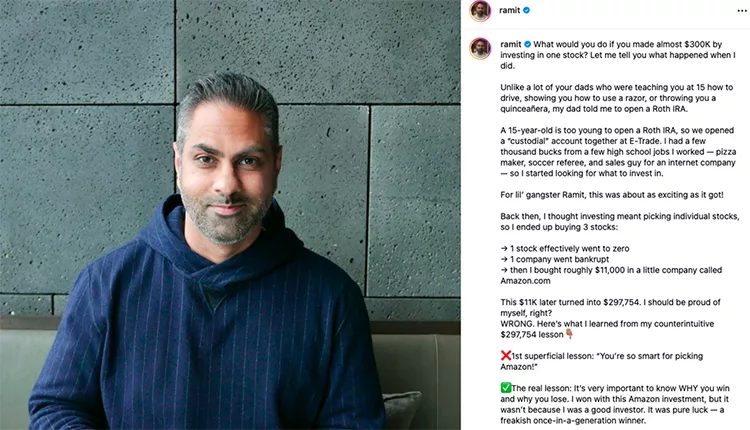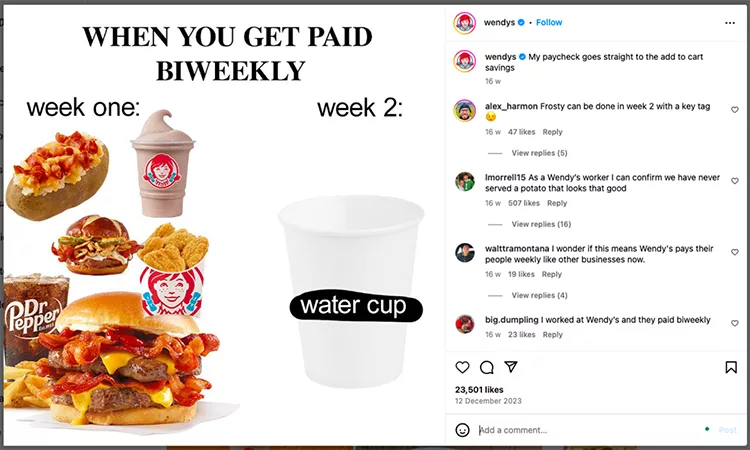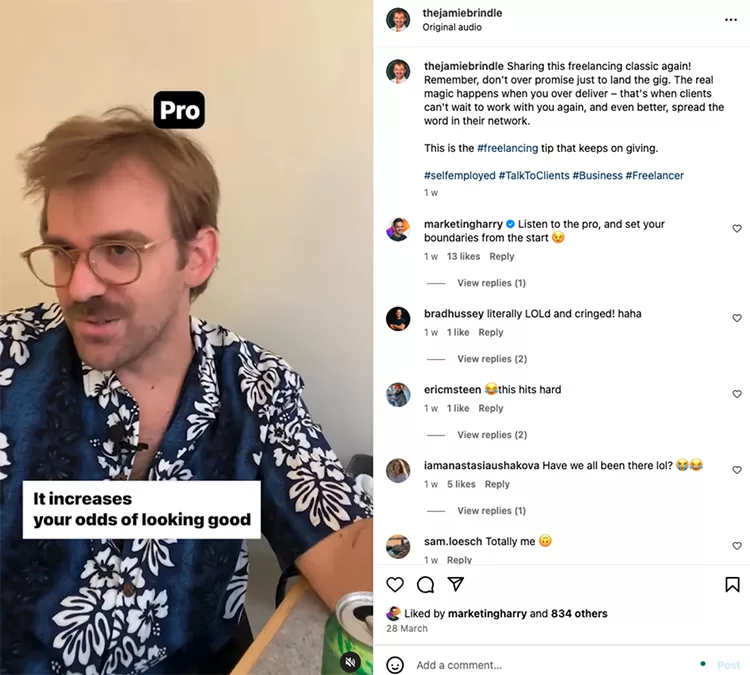When it comes to social media marketing, many people believe it’s all in the images you use.
And while those are great for grabbing initial attention, it’s the copy you use that will keep people engaged — and get them to move forward and take the action you want them to take.
The image is what will get people to stop scrolling.
But your copy is what conveys the message and your call to action.
If you want to make your copywriting as effective as possible on social media, this guide will help.
We’re going to break down 5 copywriting tips that will help you write like you want WHILE generating interest from your target audience… and driving them to take action.
Tip #1: Create a Strong Hook
A hook is what draws people in and keeps them reading.
By using an opening line or statement that engages, you’re giving them another reason to keep reading after you grab their attention with your image.
This is critical because social media is heavily saturated and, if you want people to stop scrolling, you need to immediately hook them in and show them why they should stay engaged.
There’s a handful of different ways you can create a strong hook.
Asking a Question… Then Sharing a Personal Experience
One of THE easiest ways to get someone to stop scrolling and pay attention is by simply asking a question that you already know the answer to.
Check out this example from Ramit Sethi:

In this example, Ramit opens with the question… “What would you do if you made almost $300k by investing in one stock?”
If you were interested in making money or investing in the stock market, chances are you’re going to stop scrolling.
This type of headline triggers a response in people to either continue reading to see what Ramit is talking about or to give their own answer to what they would do if they made $300,000 by investing in a single stock.
Opening With a Compelling Offer
Another great way to stop the scroll and engage your audience is by making an offer that you know people in your audience are already looking for.
Check out this example from Jenni Gritters:

Jenni uses a combination of a question to interrupt the scroll while laying out exactly what’s in it for her audience if they keep reading.
In this case, she’s letting freelancers in on the why and how of recurring revenue and how it changes their feelings about their business.
If a freelancer was currently struggling and believed that recurring income was the way for them to feel better about their business, chances are high they’re going to click through and subscribe.
Adding Value
If you want people to start recognizing your brand and stopping their scroll when they see your name, a great way to do it is by adding value with your posts.
Check out how Sunsama does it:

In this example, Sunsama is focused on helping people take a break from social media while being as effective as possible.
They’re showing people that taking periodic breaks will actually help them get more done without feeling as run down during the day.
By giving people a handful of examples of ways to do this, they’re adding value to a person’s life and then asking them to take action if they want more.
Addressing a Common Fear or Insecurity
Tapping into the common fears and insecurities your audience has is another great way to get them to stop and engage with your content.
It’s also one of the best ways to get them focused on solving the problem you can help them solve.
To see what we mean, check out this example from Ramit Sethi:

If people in his audience have ever told themselves that they’re not good with money, or that they can’t afford it, or that they’ll save money now so they can do something later, this post will hit home.
When you understand the fears and insecurities your audience is dealing with, and you have a solution to those, using them as a hook in your copy can be incredibly effective.
Reverse Psychology
If you tell someone not to do something, you can paradoxically pique their curiosity and motivate them to do the very thing they were instructed against.
This insanely powerful human urge, when used the right way, can keep people locked into your posts.
The key, though, is using it the right way.
Check out how Cole Shafer used reverse psychology:

The image he uses makes people stop and think about the message he’s trying to convey.
By getting people to do the opposite of what he said — and keep reading further — and then stop and examine the image, the algorithm sees that the person wants to see this type of content.
That means the audience will continue getting served content from Cole in the future.
Promising Multiple Valuable Insights
In the same vein as providing value with your hook, you can also promise to provide multiple valuable insights to grab people’s attention.
To see it in action, check out this example from Plum:

You can see that Plum is promising to give people 9 takes on work that makes them think.
As an additional bonus, they’re even providing one that made them chuckle a bit.
This “listicle” type of social media copywriting is incredibly effective for keeping people engaged, showing them you understand what they’re thinking, and giving you an opportunity to help them.
Rather than give people the key takeaways, though, you can see that Plum is teasing what is in store for people if they keep swiping to see more.
Tapping Into Current Trends or Events (Newsjacking)
Tapping into current events and trends, or Newsjacking is a great way to inject some personality into your social media copywriting while also grabbing attention.
This is especially true if the current trends or events are affecting your audience in some way.
To see what we mean, take a look at this example from Alex Cattoni:

Because freelancing has seen such a massive uptick in interest over the last few years, Alex knows that talking about it will grab the attention of people who haven’t already jumped in and started.
Since layoffs can leave people in a terrible situation, getting into freelancing can be a great way to secure their “job” and keep their financial house in order — even if they’ve been laid off.
The example above is a great showcase for tapping into that current trend and using it to show people there’s an alternative strategy available.
Tip #2 – Include a CTA
Now, once you’ve stopped people’s scroll with a great image and have kept their attention with great copywriting, the next step is making sure you have a CTA included.
If you’re not aware, a CTA is a “call to action” — it’s what tells people what they should do next.
A good CTA helps guide your audience on the next steps they can take, whether it’s visiting a website, signing up for a newsletter, or making a purchase.
Because social media isn’t just for “fun”, the copy you create needs to serve a purpose for your business.
There’s a wide range of CTAs you can use for your social media posts, too.
Direct CTA
A direct CTA provides clear, straightforward instructions on the action you want your audience to take.
CTAs like “Click the link in our bio to learn more!” and “Shop now by visiting our website!” are examples of direct calls to action.
Here’s another example of a social media posting using a direct CTA:

With a direct CTA, you can explicitly tell people what to do next:

Or you can make it a softer CTA:

Benefit-Driven CTA
A benefit-driven call to action focuses on telling the user what they’re going to gain by taking the action.
This type of CTA can be anything from “Sign up for exclusive access to our sale!” to “Download the guide to start improving your skills today!”.
The key with a benefit-driven CTA, though, is making sure that the benefit your audience will receive is one that actually matters to them.
Engagement-Driven CTA
An engagement-driven call to action encourages users to interact with your content.
These can be as simple as “Like if you agree and comment with your thoughts!” or “Share this with someone who needs to see it!”
When you’re using engagement-driven CTA, remember that you want your audience to feel good about engaging with your content before they consider sharing it with their network.
Here’s a great example of an engagement-driven CTA:

Curiosity-Based CTA
A curiosity-based call to action uses questions to encourage responses and engagement.
Think about a CTA along the lines of “What do you think? Drop a comment below!” or “Have you experienced this? Tell us your story!”
The key to these calls to action is to make sure the copy surrounding the CTA is something that people hold internal opinions or feelings about.
Check out this example to see what we mean:

Urgency-Driven CTA
An urgency-driven call to action focuses on prompting immediate action by implying a limited time or limited quantity.
For example, when you’re inducing urgency, you can use a CTA along the lines of “Offer ends tonight, don’t miss out!” or “Limited spots available. Register now!”.
Tip #3 – Inject Your Brand’s Personality
When you’re trying to drive engagement and sales from social media, you need to remember that people are using social media to be informed, educated, or entertained.
That means you’ll want to inject a bit of your brand’s personality if you’re going to keep them engaged with your content.
To see what we mean, here’s a casual, fun example from Garza:

Here’s another example from ClickFunnels that’s more enthusiastic, informal, and persuasive:

Or, like this example from Wendy’s, your copy can be humorous and relatable:

Paynter Jackets chooses a more conversational and intimate tone to establish a close, personal relationship with their audience:

When choosing the right tone for your brand’s social media presence, consider these dimensions:
| Dimension | Casual End | Formal End |
|---|---|---|
| Formality | Informal, Conversational | Formal, Professional |
| Approachability | Friendly, Inviting | Authoritative, Expert |
| Enthusiasm | Excited, Energetic | Measured, Composed |
| Transparency | Open and Direct | Mysterious, Intriguing |
| Humor | Funny, Comical | Witty, Subtle |
| Respectfulness | Irreverent, Challenging | Reverent, Respectful |
| Optimism | Positive, Inspirational | Realistic, Pragmatic |
| Personality | Personable, Relatable | Corporate, Neutral |
And, remember, when you’re crafting your social media CTAs, it’s important to direct users to a conversion-focused destination, like a sales funnel.
Platforms like ClickFunnels make it easy to create high-converting funnels that you can directly link to from your social media CTAs, maximizing the effectiveness of your copywriting.
With it, you can choose from pre-built, professionally designed landing page templates:

You can set the flow of your funnel to take your visitors from completely unaware to becoming an actively engaged, loyal customer:

Then, to ensure your landing pages match your brand perfectly, you can edit each page using our built-in drag-and-drop editor:

If you aren’t already driving your social media traffic to a conversion-focused, don’t keep letting high-quality traffic leak through your fingers.
Click here to start your free 14-day trial of ClickFunnels now.
Tip #4 – Format Your Copy for Readability
To make your copy as effective as possible, you need to make sure it’s readable.
If you post a wall of text to social media, you can guarantee that anyone attempting to read it is going to quickly tune out and start looking for the next post that catches their attention.
When your copy is easy to read, though, the audience is more likely to absorb the message, respond to your CTA, and remember the content later.
To see the difference, check out this example of bad formatting:

Can you imagine how hard that is to read while staying focused?
To avoid making this same mistake, make sure you’re breaking your copy into short, concise paragraphs, or even single lines, to create breathing room and help important points stand out.
Take a look at this example to see how much easier it is to read:

And this one:

You can also use text formatting to show emphasis on specific parts:

And, when used sparingly, a few emojis can really help you grab attention:

Tip #5 – Don’t Underestimate the Hashtags
Now, for our final tip on improving your social media copywriting skills, you want to make sure you aren’t forgetting about hashtags.
They help link your content to broader conversations, trending topics, and to interest-based communities, dramatically expanding your reach.
They also help categorize your content, making it discoverable to people who are searching for or following specific hashtags.
To get started, you can use branded hashtags by creating a hashtag specifically for your campaigns or general branding efforts:

You can also use a mix of generic and specific hashtags:

When you’re using hashtags, you can include them organically within the body of the copy where it makes sense, or you can list them at the end of the post.
Here’s an example of mixing it up:

You can see Jamie included #freelancing in the middle of his post and then included #selfemployed, #TalkToClients, #Business, and #Freelancer at the end, helping him show up for relevant searches.
Remember, though, the backbone of every piece of copy you create for social media revolves around getting people to take action.
And, in most cases, that means getting them to click a link that takes them away from social media so you get an opportunity to convert them into a new subscriber or customer.
If you want to do that as effectively as possible and convert as many people as possible into new subscribers and customers for your business, make sure you’re using a tool like ClickFunnels.
It will help you capture more of the attention you’re generating on social media and give you more control over how you interact with your audience as you’re building it.
If you haven’t already, click here now to start your free 14-day ClickFunnels trial.





